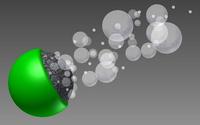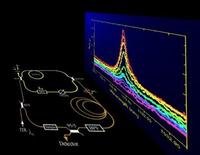-
51 labs in 17 states may have received live anthrax samples: Pentagon
Deputy Secretary of Defense Robert Work said yesterday (Wednesday) that the Pentagon may have shipped live anthrax samples to fifty-one labs in seventeen states and the District of Columbia, as well as three foreign countries. Word also said that it was likely that the numbers of labs which might have received live anthrax will go up as the Pentagon’s investigation into the shipments continues. All the samples shipped belonged to three lots, dating back to 2007, stored at the Dugway Proving Ground in Utah. CDC raises questions about the effectiveness of the method used by the Dugway lab to deactivate anthrax spores.
-
-
Better detection of diseases, fraudulent art, chemical weapons, and more
From airport security detecting explosives to art historians authenticating paintings, society’s thirst for powerful sensors is growing. Given that, few sensing techniques can match the buzz created by surface-enhanced Raman spectroscopy (SERS). Discovered in the 1970s, SERS is a sensing technique prized for its ability to identify chemical and biological molecules in a wide range of fields. It has been commercialized, but not widely, because the materials required to perform the sensing are consumed upon use, relatively expensive and complicated to fabricate. That may soon change.
-
-
Pentagon accidentally ships live anthrax from Utah to labs in nine states
The U.S. Department of Defense yesterday admitted it had accidentally shipped samples of a live anthrax spores – a potential bioweapon — across nine states and to a U.S. air base in South Korea. The Pentagon revealed what it described as an “inadvertent transfer of samples containing live Bacillus anthracis” from a DoD laboratory in Dugway Proving Ground, Utah to labs in nine states. The mishap alarmed biosafety experts. “These events shouldn’t happen,” said one.
-
-
New biosensor can detect listeria contamination in two minutes
Engineers have developed a biosensor that can detect listeria bacterial contamination within two or three minutes. The same technology can be developed to detect other pathogens such as E. coli O157:H7, but listeria was chosen as the first target pathogen because it can survive even at freezing temperatures. It is also one of the most common foodborne pathogens in the world and the third-leading cause of death from food poisoning in the United States.
-
-
Keeping biotechnology research safe
Increasingly, scientists across the world and in the Unites States are reporting new and groundbreaking innovations in biotechnology with transformative implications in human health and environmental sustainability. While these technologies are developed in laboratories, researchers are not only giving utmost consideration to the potential beneficial impacts but also to a new set of potential risks arising in synthetic biology research. It is crucial that scientists employ the highest level of safety measures within the laboratory to prevent any unintentional effects on human health or environment. The Wyss Institute is developing a proactive biosafety process to review all proposed biotechnology research and manage potential risks pre-emptively.
-
-
Food safety specialists hope new tracking approach will lead to better intervention
Estimates from the Centers for Disease Control and Prevention show these four pathogens cause 1.9 million cases of foodborne illness in the United States each year. A new partnership to improve food safety and better track foodborne illness is an approach that food safety specialists say will lead to better intervention strategies.
-
-
New detection method for bacterial toxin
The Bacillus cereus bacterium is one of the potential causes of food poisoning. A recent study in Analytical and Bioanalytical Chemistry shows that this versatile pathogen produces nineteen different variants of a poison that causes nausea and vomiting in human beings. This variety could explain why some cases are relatively benign and others can result in death. Across Europe, the number of food poisoning cases caused by the Bacillus species is on the rise.
-
-
DHS termination of bio-detection contract questioned
In February 2014, six months before Silicon Valley startup NVS delivered the first prototypes of its polymerase chain reaction (PCR) pathogen detector to DHS, the department sent NVS’s chief executive Hans Fuernkranz a notice terminating the project. According to a 26 November 2014 draft audit report by DHS’s inspector general’s office, the decision was improperly made by a single agency official without supporting evidence and “against S&T [DHS Science & Technology Directorate] subject matter expert advice.”The official who made the decision to cancel the project had expressed concerns about the cost associated with the NVS contract, and said the contract was terminated because existing technologies could better meet the agency’s needs for confronting bio-threats. The auditors say, however, that they “did not identify evidence to substantiate any of the concerns.”
-
-
Meals served to Turkey’s president Erdogan tested for poison
Turkish president Recep Tayyip Erdogan has implemented strict new measures to protect his personal security. One of these measures: Every meal he is served – both at home and abroad — is rigorously tested to make sure it does not contain any poisonous materials inserted by a would-be assassin. Dr. Cevdet Erdol, Erdogan’s personal physician, said that a special food analysis laboratory will be built at Erdogan’s lavish presidential palace to make sure all his food is safe to eat. “It’s usually not through bullets that prominent figures are being assassinated these days,” Erdol told the Hurriyet newspaper on Tuesday.
-
-
Sandia Labs anthrax detector wins national technology transfer award
Bacillus anthracis, the anthrax bacteria, is found in soils worldwide and can cause serious, often fatal, illness in humans and animals. It can survive in harsh conditions for decades. Humans can be exposed through skin contact, inhalation of spores or eating contaminated meat. Currently, samples for testing must be propagated in a laboratory that uses specialized tools requiring a consistent power supply, something often unavailable in the developing world. Sandia National Laboratories won the Federal Laboratory Consortium’s (FLC) 2015 Award for Excellence in Technology Transfer for a credit-card-size device that can detect bacteria that cause anthrax.
-
-
Mobile app helps first responders choose the right biodetection technology
First responders have downloaded more than 10,000 copies of a guide to commercially available, hand-portable biodetection technologies created to help them determine what they might be up against in the field. Since many first responders do not always have immediate access to a computer, a mobile version of the guide is now available for cell phones and tablets. An updated version of the guide has just been released to help response organizations make informed decisions when procuring the right technology for their particular needs and circumstances.
-
-
New acoustic sensor for chemical, biological detection
Testing for ovarian cancer or the presence of a particular chemical could be almost as simple as distinguishing an F sharp from a B flat, thanks to a new microscopic acoustic device that has been dramatically improved by scientists at the Argonne National Laboratory. The device, known as a surface acoustic wave (SAW) sensor, detects frequency changes in waves that propagate through its crystalline structure. This makes it ideal for detecting the presence of chemicals or biomarkers present in a liquid or gas.
-
-
Microrockets fueled by water neutralize chemical and biological warfare agents

With fears growing over chemical and biological weapons falling into the wrong hands, scientists are developing microrockets to fight back against these dangerous agents. Scientists point out that titanium dioxide is one of the most promising materials available for degrading chemical and biological warfare agents. It does not require harsh chemicals or result in toxic by-products. There is no way, however, actively to mix titanium dioxide in waterways, so scientists have been working on ways to propel titanium dioxide around to accelerate the decontamination process without the need for active stirring.
-
-
Light frequencies help sniff out deadly materials from a distance

Spectroscopic chemical sensing, which measures the frequency of light absorbed or scattered from a substance to help determine its molecular identity, can be used to detect traces of biological and chemical agents and residue from explosive materials. New program aims to develop chip-sized, optical frequency combs which accurately identify even tiny traces of dangerous biological and chemical substances several football fields away.
-
-
IAEA to provide nuclear detection technology to help diagnose Ebola in West Africa
The International Atomic Energy Agency (IAEA) said it would provide specialized diagnostic equipment to help Sierra Leone in its efforts to combat the Ebola Virus Disease (EVD) outbreak. Later, the support is planned to be extended to Liberia and Guinea. The support is in line with a UN Security Council appeal and responds to a request from Sierra Leone. The IAEA assistance will supplement the country’s ability to diagnose EVD quickly using a diagnostic technology known as Reverse Transcriptase Polymerase Chain Reaction (RT-PCR). RT-PCR is a nuclear-derived technology which allows EVD to be detected within a few hours, while other methods require growing on a cell culture for several days before a diagnosis is determined.
-
- All
- Regional
- Water
- Biometrics
- Borders/Immig
- Business
- Cybersecurity
- Detection
- Disasters
- Government
- Infrastructure
- International
- Public health
- Public Safety
- Communication interoperabillity
- Emergency services
- Emergency medical services
- Fire
- First response
- IEDs
- Law Enforcement
- Law Enforcement Technology
- Military technology
- Nonlethal weapons
- Nuclear weapons
- Personal protection equipment
- Police
- Notification /alert systems
- Situational awareness
- Weapons systems
- Sci-Tech
- Sector Reports
- Surveillance
- Transportation
Advertising & Marketing: advertise@newswirepubs.com
Editorial: editor@newswirepubs.com
General: info@newswirepubs.com
2010-2011 © News Wire Publications, LLC News Wire Publications, LLC
220 Old Country Road | Suite 200 | Mineola | New York | 11501
Permissions and Policies
Editorial: editor@newswirepubs.com
General: info@newswirepubs.com
2010-2011 © News Wire Publications, LLC News Wire Publications, LLC
220 Old Country Road | Suite 200 | Mineola | New York | 11501
Permissions and Policies
